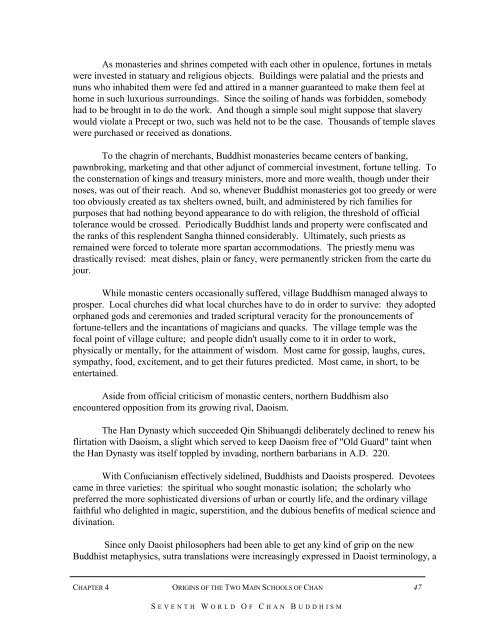seventh world of chan buddhism - Zen Buddhist Order of Hsu Yun
seventh world of chan buddhism - Zen Buddhist Order of Hsu Yun
seventh world of chan buddhism - Zen Buddhist Order of Hsu Yun
Create successful ePaper yourself
Turn your PDF publications into a flip-book with our unique Google optimized e-Paper software.
As monasteries and shrines competed with each other in opulence, fortunes in metals<br />
were invested in statuary and religious objects. Buildings were palatial and the priests and<br />
nuns who inhabited them were fed and attired in a manner guaranteed to make them feel at<br />
home in such luxurious surroundings. Since the soiling <strong>of</strong> hands was forbidden, somebody<br />
had to be brought in to do the work. And though a simple soul might suppose that slavery<br />
would violate a Precept or two, such was held not to be the case. Thousands <strong>of</strong> temple slaves<br />
were purchased or received as donations.<br />
To the chagrin <strong>of</strong> mer<strong>chan</strong>ts, <strong>Buddhist</strong> monasteries became centers <strong>of</strong> banking,<br />
pawnbroking, marketing and that other adjunct <strong>of</strong> commercial investment, fortune telling. To<br />
the consternation <strong>of</strong> kings and treasury ministers, more and more wealth, though under their<br />
noses, was out <strong>of</strong> their reach. And so, whenever <strong>Buddhist</strong> monasteries got too greedy or were<br />
too obviously created as tax shelters owned, built, and administered by rich families for<br />
purposes that had nothing beyond appearance to do with religion, the threshold <strong>of</strong> <strong>of</strong>ficial<br />
tolerance would be crossed. Periodically <strong>Buddhist</strong> lands and property were confiscated and<br />
the ranks <strong>of</strong> this resplendent Sangha thinned considerably. Ultimately, such priests as<br />
remained were forced to tolerate more spartan accommodations. The priestly menu was<br />
drastically revised: meat dishes, plain or fancy, were permanently stricken from the carte du<br />
jour.<br />
While monastic centers occasionally suffered, village Buddhism managed always to<br />
prosper. Local churches did what local churches have to do in order to survive: they adopted<br />
orphaned gods and ceremonies and traded scriptural veracity for the pronouncements <strong>of</strong><br />
fortune-tellers and the incantations <strong>of</strong> magicians and quacks. The village temple was the<br />
focal point <strong>of</strong> village culture; and people didn't usually come to it in order to work,<br />
physically or mentally, for the attainment <strong>of</strong> wisdom. Most came for gossip, laughs, cures,<br />
sympathy, food, excitement, and to get their futures predicted. Most came, in short, to be<br />
entertained.<br />
Aside from <strong>of</strong>ficial criticism <strong>of</strong> monastic centers, northern Buddhism also<br />
encountered opposition from its growing rival, Daoism.<br />
The Han Dynasty which succeeded Qin Shihuangdi deliberately declined to renew his<br />
flirtation with Daoism, a slight which served to keep Daoism free <strong>of</strong> "Old Guard" taint when<br />
the Han Dynasty was itself toppled by invading, northern barbarians in A.D. 220.<br />
With Confucianism effectively sidelined, <strong>Buddhist</strong>s and Daoists prospered. Devotees<br />
came in three varieties: the spiritual who sought monastic isolation; the scholarly who<br />
preferred the more sophisticated diversions <strong>of</strong> urban or courtly life, and the ordinary village<br />
faithful who delighted in magic, superstition, and the dubious benefits <strong>of</strong> medical science and<br />
divination.<br />
Since only Daoist philosophers had been able to get any kind <strong>of</strong> grip on the new<br />
<strong>Buddhist</strong> metaphysics, sutra translations were increasingly expressed in Daoist terminology, a<br />
CHAPTER 4 ORIGINS OF THE TWO MAIN SCHOOLS OF CHAN<br />
S EVENTH W ORLD O F C HAN B UDDHISM<br />
47


